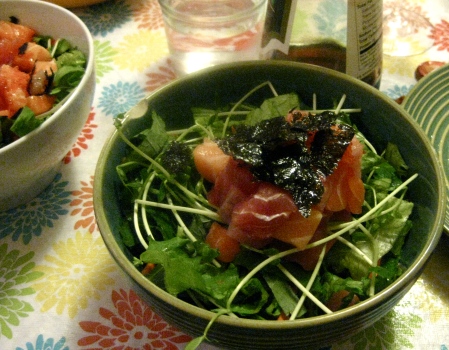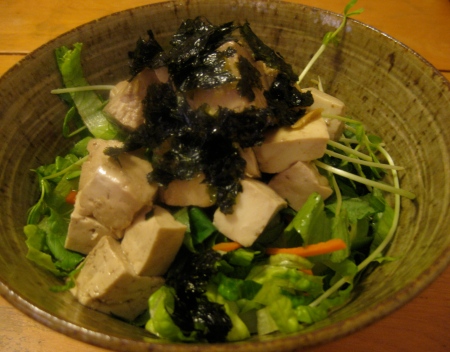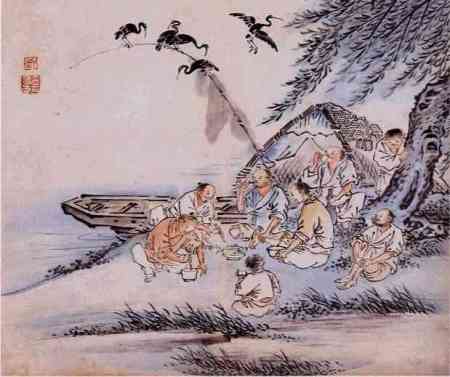Koreans have been eating raw fish for longer than the Japanese. I’m not just being a Korean nationalist; it’s true. It’s not just Wikipedia that says so. The Oxford Companion to Food agrees that raw, fermented fish originated in the Mekong Delta, spread to China and then eventually to Japan, and everyone knows Korea is on the way from China to Japan.
But Japanese sushi/sashimi is more famous than Korean 회, hoe, and the annoyance I feel about that is nationalistic. As I served 회덮밥, hoe dup bap to my guests this past Sunday, I found myself calling it a “Korean chirashi” when it’s not anything like chirashi. I know it doesn’t really matter, but the little kid in me wanted to wail, “Why can’t the Japanese be eating Japanese hoe dup bap?”

Hoe dup bap literally means “raw fish on rice.” Chirashi is also raw fish on rice. The two dishes are similar because the cultures have a lot in common—oceans and rice fields—but ultimately, hoe dup bap and chirashi are only as similar as pasta and spaetzle. Same ingredients, different flavors, different food values.
Chirashi is just barely seasoned—the slight vinegar flavor of sushi rice, the fish maybe touched a bit by soy sauce and wasabi. The Japanese revere raw fish. Koreans—I’m not sure what emotion we feel for raw fish, but it’s definitely not reverence. When we see a bowl of raw fish on rice, we want to drizzle it with sesame oil and then squeeze on a spicy-sweet-and-sour red pepper sauce.
The lack of reverence continues in how the hoe dup bap is eaten. According to this Chowhound thread, the bowl of chirashi should be left relatively undisturbed. Korean hoe dup bap, though, is supposed to be mixed up. Koreans have long-handled spoons for a reason, and even if it’s not so pretty, the rice, the fish, the greens all take on the red tint of the spicy pepper sauce. Each spoonful should include all the flavors and textures, the smoothness of the fish, the crunch of the vegetables, soft texture of the rice, and of course, the fragrance of sesame oil and red pepper sauce. It’s another example of the Korean love of things “bibim” or “mixed.”
What I do appreciate in both dishes, though, is the rawness of the flavors. Even with all that heat and sesame oil, hoe dup bap is one of my favorite things to eat when it’s hot and sticky. If I’ve been traveling, especially in a country that cooks mainly with cream and butter, the first thing I want to eat when I get home is hoe dup bap. Hoe dup bap is practically a salad as much as a rice dish, with all the shredded lettuce, carrots, cucumbers, sprouts and perilla leaves. It’s incredibly cleansing and refreshing at the same time.
Last night was the first time I made it at home, and now that I know how easy it is, it’s going to be my go-to summer dish, especially on those nights that it’s too hot to turn on the stove. There’s literally nothing to cook except the rice, which can be done with the press of a button if you have a rice cooker. It’s easy to make for one or for two, or for twelve.
Sashimi-grade fish is available at Japanese stores, and often at Korean groceries as well. I found mine at Sunrise Mart, a Japanese grocery in the East Village, and then ended up finding and buying another block of tuna at M2M, the more Korean-focused store a few blocks north. It can get expensive buying sashimi-grade fish, but you don’t need as much as you might for chirashi, since you have so much else going on.

If you don’t have a reputable fishmonger or don’t eat fish, you can substitute tofu. I made a marinated tofu version for a guest who can’t eat raw fish. I got the idea from Maangchi, who recommends that you fry the tofu, but I thought leaving it uncooked would better approximate the texture, if not the flavor, of raw fish. I used the leftovers to make a bowl of “dubu dup bap” for my Monday dinner. I was surprised, it was quite good.
Hoe dup bap (for one)
1.5-2 cups of cooked white rice
¾ cup of raw fish cut into one-inch cubes, about a quarter pound—I used an assortment of tuna, salmon and hamachi or yellowtail
1 teaspoon of fish roe
handful of shredded lettuce, like romaine or green leaf
¼ cup of julienned carrots
¼ cup of julienned cucumbers (try Persian if you can’t find Korean, something fairly seedless)
3-4 perilla leaves, cut into thin strips (optional)
sprouts (radish or pea, anything thin and crunchy with bright green tops)
a couple of thin strips of roasted seaweed
drizzle of sesame oil (about 1 teaspoon)
chojang, or spicy sauce, to taste
1. Place the rice in the bottom of the bowl.
2. Add the lettuce, the julienned carrots and cucumbers, the perilla leaves, and sprouts. The perilla leaves are optional, as they can only be found in Korean and Japanese grocery stores, but they’re so good and fragrant if you can find them.
3. Top with the raw fish. Sprinkle the fish roe on top of the fish.
4. Garnish with a few thin strips of roasted seaweed, drizzle with sesame oil, and add chojang to taste.
Chojang or spicy red pepper sauce
3 tablespoons gochujang, or red pepper paste
2 tablespoons vinegar (white wine, rice or brown rice)
1 tablespoon sugar
Mix thoroughly and taste. Depending on your brand of gochujang, you might want to add more or less vinegar and sugar. It should be much thinner than gochujang, though not as thin as a hot sauce, as easily pourable as sriracha sauce. I’m planning to play around with the chojang recipe a bit, as there are some interesting variations I’ve found in different sources, but it’s totally serviceable if you are craving a simple, fresh Korean raw fish dinner now.
Variation: Replace the raw fish with cubes of marinated, uncooked tofu. I cut up a package of firm tofu and marinated it in a mix of soy sauce, sugar, ginger, garlic, sesame oil, and lemon juice.



